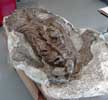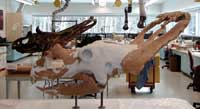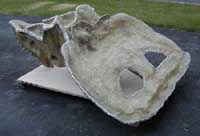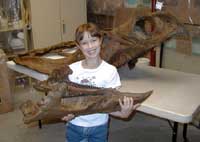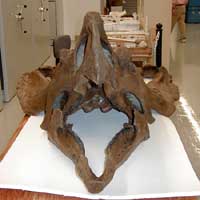|
Reconstructing the skull of a new species of Chasmosaur This
article will detail the reconstruction of the skull of a new species of
Chasmosaur (CMN 41357)
for the Canadian Museum of Nature (CMN). The new species has been described and
named as Chasmosaurus irvinensis by
Dr. Robert B. Holmes, Catherine
Forster, Michael Ryan, and Kieran Shepherd
In 1958 former CMN paleontologist Wann Langston collected an articulated
ceratopsian specimen he thought was likely a Chasmosaurus
belli. Since the Museum already had two excellent prepared and mounted C.
belli this specimen was left in itís field jacket until 1990 when it was
opened to inspect the front legs in the hopes of resolving the debate over
straight or bent legs in ceratopsidae. As luck would have it the side that was
opened revealed a frill that was different-enough from previously known
Chasmosaurs to suggest that this one might be a species previously unknown to
science! Preparation by Senior Collection Technician Clayton Kennedy in 1997/98 had yielded roughly 75% of the skull. The skull had been collected in two field jackets as the face was disarticulated in matrix (pre-fossilization). Subsequent erosion had resulted in the loss of much of the left side of the face. The entire brain case and palate were also lost. The main field jacket contained the skeleton and skull frill (Fig 1).
My
job was to mold and cast the surviving holotype (specimen that serves as the
basis for naming and describing a new species) elements and incorporate the
casts into a sculpted reconstruction of the skull under the direction of
Research Associate Dr. Robert B. Holmes. Luckily where elements were missing on
one side they were for the most part preserved on the opposite. I was also aided
by the beautifully detailed illustrations that Dr. Holmes had prepared for his
paper on this new species. I also used an incredibly well preserved skull of C.
russelli (NMC 2280) as reference for missing elements such as the brain
case. The
first step was to mold the 23 surviving elements of the skull. Molding fossil
dinosaur material is always a tricky proposition as it is extremely fragile and
an improperly planned or executed mould that puts excessive stress on the fossil
can result in breakage or in a worse case scenario, a pile of unrecoverable
sand. The fact that this was holotype material made it even more nerve racking.
I used plasticine to dam up my mold separations and block off any pass throughs
on all of the pieces and then applied a mold release (Fig. 2). Polytek 74-30
polyurethane molding rubber was then applied starting first with a slightly
thickened layer to avoid penetration of the fossils. Several more layers were
built up including one reinforced with cheesecloth. Plaster jackets were made to
support each thin rubber mold section. The large one-piece frill was
These
molds were then used to make epoxy casts of each of the elements. A few of the
elements had been distorted post mortem so I had to modify them so they could be
aligned properly with the adjoining parts of the skull. These included the
rostral and predentary which had been compressed. There was also distortion to a
section of the right postorbital and anterior squamosal. Using the sketches by
Dr.Holmes as reference, I then sculpted a polyethylene foam form of the skull.
The brown epoxy casts were fitted onto this form. The missing elements of the
polyethylene form were then carved to match up with the existing pieces. After
approval by Dr. Holmes I set about the task of modeling the texture of the
missing skull sections with Magic Sculpt two-part epoxy putty.
After
the approval was received I made Polytek moulds with FRP jackets of the skull
and the lower jaw (Fig. 5). Lightweight FRP casts were made from these moulds.
After a clean up of the casts I then painted the finished skull and jaw with artist's oil colours (Fig, 7, 8 & 9). The skull was painted to match the original skull elements and there are plans to mount the cast on the postcranial material that is being prepared as I write. The finished skeleton will then be displayed in the planned new Fossil Gallery at the Canadian Museum of Nature.
This
was a very rewarding project and I consider working with Dr Robert Holmes on the
first reconstruction of the Chasmosaurus
irvinensis holotype skull to be one of the highlights of my career and I
thank him for the experience. I wish to express my appreciation to Kieran
Shepherd, Chief, Earth Sciences Collections and Mary-Rose Saccu, Project Manager
for the opportunity to work on this project. Many thanks to Clayton Kennedy for
his input on the reconstruction and for his help with the specimens. Thank you
also to Margaret Feuerstack from Collections for her help in preparing the
specimens for transport to my shop. If
you would like more information on Chasmosaurus
irvinensis see: The Canadian Museum of Nature's at
their web-site www.nature.ca The
Canadian Museum of Nature is located at 240 McLeod Street (at Metcalfe), Ottawa,
Ontario, Canada.
! Artwork shown at this site is copyright protected by the Artist ! |
||||||||||||||||||
